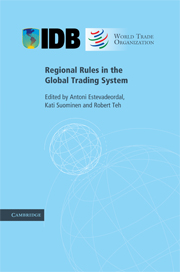Book contents
- Frontmatter
- Contents
- List of figures
- List of tables
- List of Contributors
- Foreword
- Acknowledgements
- List of abbreviations
- 1 Introduction
- 2 Big-Think Regionalism: a critical survey
- 3 Market access provisions in regional trade agreements
- 4 Trade remedy provisions in regional trade agreements
- 5 A mapping of regional rules on technical barriers to trade
- 6 Services liberalization in the new generation of preferential trade agreements: how much further than the GATS?
- 7 Mapping investment provisions in regional trade agreements: towards an international investment regime?
- 8 Competition provisions in regional trade agreements
- Appendix: List of RTAs included in the survey
- Index
1 - Introduction
Published online by Cambridge University Press: 01 March 2011
- Frontmatter
- Contents
- List of figures
- List of tables
- List of Contributors
- Foreword
- Acknowledgements
- List of abbreviations
- 1 Introduction
- 2 Big-Think Regionalism: a critical survey
- 3 Market access provisions in regional trade agreements
- 4 Trade remedy provisions in regional trade agreements
- 5 A mapping of regional rules on technical barriers to trade
- 6 Services liberalization in the new generation of preferential trade agreements: how much further than the GATS?
- 7 Mapping investment provisions in regional trade agreements: towards an international investment regime?
- 8 Competition provisions in regional trade agreements
- Appendix: List of RTAs included in the survey
- Index
Summary
Introduction
Regional trade agreements (RTAs) have proliferated around the world in the past decade. Some 200 RTAs currently in force have been notified to the World Trade Organization (WTO) and the number will continue to rise given the many RTAs being proposed and negotiated. It is estimated that, if one takes into account RTAs which are in force but have not been notified, signed but not yet in force, currently being negotiated, and in the proposal stage, close to 400 RTAs are scheduled to be implemented by 2010 (Fiorentino, Verdeja and Toqueboeuf, 2006).
Virtually all countries are member of at least one RTA, with most countries belonging to two or more RTAs at once. The geographic reach of RTAs has also changed over time, making ‘regional’ somewhat of a misnomer. While most RTAs are still formed among countries inhabiting the same region or continent, they increasingly involve members that are not immediate neighbours and create partnerships spanning oceans. Trans-Atlantic and trans-Pacific RTAs are gaining in number through such agreements as the European Union (EU)–Mexico Economic Partnership Agreement, the EFTA–Chile free trade agreement (FTA) and the recently signed Korea–US FTA.
The economic importance of regional trade agreements has continued to grow. More than half of global merchandise trade flows among countries connected by a common RTA. But RTAs are today increasingly important in areas other than merchandise trade.
- Type
- Chapter
- Information
- Regional Rules in the Global Trading System , pp. 1 - 16Publisher: Cambridge University PressPrint publication year: 2009



